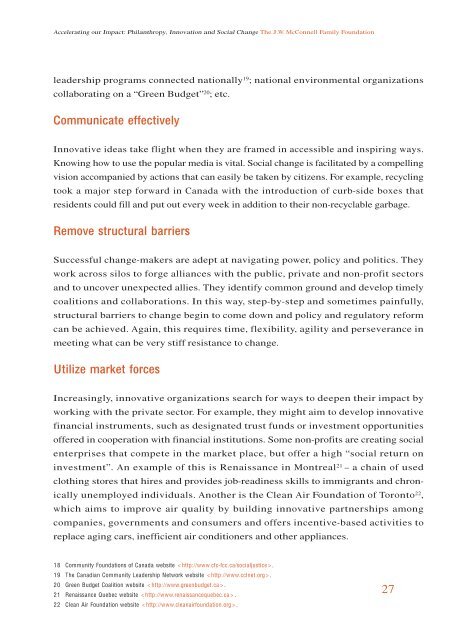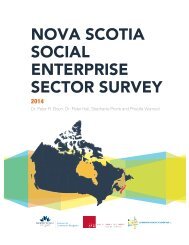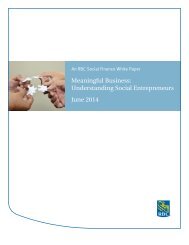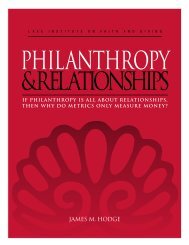Accelerating our Impact: Philanthropy, Innovation and Social Change
Create successful ePaper yourself
Turn your PDF publications into a flip-book with our unique Google optimized e-Paper software.
As social marketer Eric Young has observed, “<strong>Social</strong> innovation is not just about<br />
improving the innovative capacity of social organizations. Rather, it is about innovations<br />
in <strong>our</strong> capacity to organize social <strong>and</strong> financial res<strong>our</strong>ces to achieve large-scale<br />
social impact.”<br />
Finally, adept social innovators<br />
• balance thinking <strong>and</strong> acting, st<strong>and</strong>ing still in order to perceive system<br />
patterns <strong>and</strong> moving quickly to take advantage of opportunities;<br />
• engage both the power of established institutions <strong>and</strong> that of the grassroots;<br />
• manage both the dynamics of success <strong>and</strong> the dynamics of failure <strong>and</strong> are not<br />
drawn off c<strong>our</strong>se by either. 23<br />
When Cindy Blackstock, Executive Director of First Nations Child <strong>and</strong> Family<br />
Caring Society 24 , studied the enormous gap that existed between the Canadian<br />
voluntary sector <strong>and</strong> First Nations agencies dealing with children <strong>and</strong> families,<br />
she discovered a self-perpetuating stalemate. Agencies on reserves were reluctant<br />
to get in touch with voluntary agencies because they had no experience of<br />
working with them, few if any contacts, <strong>and</strong> a history that advised strongly<br />
against inviting outsiders to work on questions of child welfare. On the other<br />
side of this cultural divide, voluntary agencies refrained from getting involved<br />
on reserves, saying “We don’t go where we are not invited.”<br />
2.1<br />
Beyond funding<br />
Cindy is a classic social innovator: she sees opportunities where others see barriers<br />
<strong>and</strong> she is willing to do whatever it takes to achieve results for her community.<br />
She began to systematically remove obstacles by creating the Caring Across<br />
Boundaries (CAB) program. Using a curriculum developed by First Nations writers,<br />
CAB provides workshops to on-reserve family <strong>and</strong> child welfare agencies,<br />
<strong>and</strong> to voluntary sector organizations, informing each about the nature <strong>and</strong><br />
approach of the other. Through structured encounters hosted by the reserve,<br />
mutual underst<strong>and</strong>ing leads to joint agenda setting <strong>and</strong> a range of collaborative<br />
projects, such as an Aboriginal Mentorship Project in collaboration with the Boys<br />
<strong>and</strong> Girls Clubs of Canada. Trust is slowly building <strong>and</strong> families <strong>and</strong> children are<br />
benefiting as a result.<br />
28<br />
23 These abilities with corresponding examples are described by Frances Westley, Brenda Zimmerman <strong>and</strong><br />
Michael Quinn Patton in Getting to Maybe: How the World is <strong>Change</strong>d, Toronto: R<strong>and</strong>om House, 2006.<br />
24 For more information on this initiative, visit: < http://www.fncfcs.com > .







